A
lunar eclipse occurs when the
Moon passes directly behind the
Earth into its
umbra (shadow). This can occur only when the sun, Earth, and moon are aligned (in "
syzygy") exactly, or very closely so, with the Earth in the middle. Hence, a lunar eclipse can occur only the night of a
full moon. The type and length of an
eclipse depend upon the Moon's location relative to its
orbital nodes.
A total lunar eclipse has the direct sunlight completely blocked by the earth's shadow. The only light seen is refracted through the earth's shadow. This light looks red for the same reason that the sunset looks red, due to
rayleigh scattering of the more blue light. Because of its reddish color, a total lunar eclipse is sometimes called a
blood moon.
Unlike a
solar eclipse, which can be viewed only from a certain relatively small area of the world, a lunar eclipse may be viewed from anywhere on the night side of the Earth. A lunar eclipse lasts for a few hours, whereas a total solar eclipse lasts for only a few minutes at any given place, due to the smaller size of the Moon's shadow. Also unlike solar eclipses, lunar eclipses are safe to view without any eye protection or special precautions, as they are dimmer than the full moon.
For the date of the next eclipse see the section
Recent and forthcoming lunar eclipses.
Types of lunar eclipse

Schematic diagram of the shadow cast by the Earth. Within the central
umbra shadow, the moon is totally shielded from direct illumination by the Sun. In contrast, within the
penumbra shadow, only a portion of Sunlight is blocked.

A
total penumbral lunar eclipse dims the moon in direct proportion to the area of the Sun's disk blocked by the Earth. This comparison shows the southern shadow penumbral lunar eclipse of
January 1999 (left) to the moon outside of the shadow (right) demonstrates this subtle dimming.
The shadow of the Earth can be divided into two distinctive parts: the
umbra and
penumbra. Within the umbra, there is no direct solar radiation. However, as a result of the Sun's large angular size, solar illumination is only partially blocked in the outer portion of the Earth's shadow, which is given the name penumbra.
A
penumbral eclipse occurs when the moon passes through the Earth's penumbra. The penumbra causes a subtle darkening of the moon's surface. A special type of penumbral eclipse is a
total penumbral eclipse, during which the Moon lies exclusively within the Earth's penumbra. Total penumbral eclipses are rare, and when these occur, that portion of the moon which is closest to the umbra can appear somewhat darker than the rest of the moon.
A
partial lunar eclipse occurs when only a portion of the moon enters the umbra. When the moon travels completely into the Earth's umbra, one observes a
total lunar eclipse. The moon's speed through the shadow is about one kilometer per second (2,300 mph), and totality may last up to nearly 107 minutes. Nevertheless, the total time between the moon's first and last contact with the shadow is much longer and could last up to four hours.
[1] The relative distance of the moon from the Earth at the time of an eclipse can affect the eclipse's duration. In particular, when the moon is near its
apogee, the farthest point from the Earth in its orbit, its orbital speed is the slowest. The diameter of the umbra does not decrease appreciably within the changes in the orbital distance of the moon. Thus, a totally eclipsed moon occurring near apogee will lengthen the duration of totality.
A
central lunar eclipse is a total lunar eclipse during which the moon passes through the centre of the Earth's shadow. These are
relatively rare.
Selenelion
A
selenelion or
selenehelion occurs when both the Sun and the eclipsed Moon can be observed at the same time. This can happen only just before sunset or just after sunrise, and both bodies will appear just above the horizon at nearly opposite points in the sky. This arrangement has led to the phenomenon being referred to as a
horizontal eclipse. There are typically a number of high ridges undergoing sunrise or sunset that can see it. Although the moon is in the Earth’s umbra, the Sun and the eclipsed Moon can both be seen at the same time because the
refraction of light through the
Earth’s atmosphere causes each of them to appear higher in the sky than their true geometric position.
[2]
Timing
![]()
As viewed from Earth, the Earth’s shadow can be imagined as two concentric circles. As the diagram illustrates, the type of lunar eclipse is defined by the path taken by the Moon as it passes through Earth’s shadow. If the moon passes through the outer circle but does not reach the inner circle, it is a penumbral eclipse; if only a portion of the moon passes through the inner circle, it is a partial eclipse; and if entire Moon passes through the inner circle at some point, it is a total eclipse.
![]()
Contact points relative to the Earth's umbral and penumbral shadows, here with the Moon near is descending node
The timing of total lunar eclipses are determined by its contacts:
[3]
- P1 (First contact): Beginning of the penumbral eclipse. Earth's penumbra touches the Moon's outer limb.
- U1 (Second contact): Beginning of the partial eclipse. Earth's umbra touches the Moon's outer limb.
- U2 (Third contact): Beginning of the total eclipse. The Moon's surface is entirely within Earth's umbra.
- Greatest eclipse: The peak stage of the total eclipse. The Moon is at its closest to the center of Earth's umbra.
- U3 (Fourth contact): End of the total eclipse. The Moon's outer limb exits Earth's umbra.
- U4 (Fifth contact): End of the partial eclipse. Earth's umbra leaves the Moon's surface.
- P4 (Sixth contact): End of the penumbral eclipse. Earth's penumbra no longer makes contact with the Moon.
Danjon scale
The following scale (the
Danjon scale) was devised by
André Danjon for rating the overall darkness of lunar eclipses:
[4]
- L=0: Very dark eclipse. Moon almost invisible, especially at mid-totality.
- L=1: Dark eclipse, gray or brownish in coloration. Details distinguishable only with difficulty.
- L=2: Deep red or rust-colored eclipse. Very dark central shadow, while outer edge of umbra is relatively bright.
- L=3: Brick-red eclipse. Umbral shadow usually has a bright or yellow rim.
- L=4: Very bright copper-red or orange eclipse. Umbral shadow is bluish and has a very bright rim.
Lunar versus solar eclipse
![]()
A solar eclipse occurs in the day time at new moon, when the moon is between the Earth and the sun, while a lunar eclipse occurs at night when the Earth passes between the Sun and the Moon.
There is often confusion between a solar and lunar eclipse. While both involve interactions between the sun, Earth, and moon, they are very different in their interactions.
Lunar eclipse appearance
![]()
A lunar eclipse occurs in two regions, an outer penumbral shadow where the sunlight is dimmed, and an inner umbral shadow, where much dimmer sunlight only exists by refraction through the Earth's atmosphere, leaving a red color. This can be seen in different exposures of a partial lunar eclipse, for example here with exposures of 1/80, 2/5, and 2 seconds.
The moon does not completely disappear as it passes through the umbra because of the
refraction of
sunlight by the Earth's atmosphere into the shadow cone; if the Earth had no atmosphere, the Moon would be completely dark during an eclipse.
[5] The reddish coloration arises because sunlight reaching the Moon must pass through a long and dense layer of the Earth's atmosphere, where it is
scattered. Shorter
wavelengths are more likely to be scattered by the air molecules and the small particles, and so by the time the light has passed through the atmosphere, the longer wavelengths dominate. This resulting light we perceive as
red. This is the same effect that causes
sunsets and
sunrises to turn the sky a reddish color; an alternative way of considering the problem is to realize that, as viewed from the moon, the sun would appear to be setting (or rising) behind the Earth.
![]()
From the Moon, a lunar eclipse would show a ring of reddish-orange light surrounding a dark Earth in the sky.
The amount of refracted light depends on the amount of dust or clouds in the atmosphere; this also controls how much light is scattered. In general, the dustier the atmosphere, the more that other wavelengths of light will be removed (compared to red light), leaving the resulting light a deeper red color. This causes the resulting coppery-red hue of the moon to vary from one eclipse to the next. Volcanoes are notable for expelling large quantities of dust into the atmosphere, and a large eruption shortly before an eclipse can have a large effect on the resulting color.
March 1504 lunar eclipse
![]()
Christopher Columbus predicting the lunar eclipse.
When
Christopher Columbus came to the
New World—specifically, the north coast of Jamaica—he was able to use European scientific understanding to correctly predict a lunar eclipse. The event is known as the
March 1504 lunar eclipse and occurred when Columbus, after he wanted to be seen as god-like, stated that he would make the moon disappear during the night of February 29, 1504. The reason Columbus wanted to prove he could make the moon disappear is because he and his crew were eating a great deal of the inhabitants' food, and the inhabitants refused to feed them anymore. Columbus was right in his prediction, for he used astronomical tables and local clocks in order to predict when the lunar eclipse would happen and was able to convince the inhabitants that he had the power to make the moon disappear and then reappear. After the inhabitants believed that Columbus was truly able to make the moon disappear, they begged him to return the moon to its previous form, and after roughly an allotted amount of time (the amount of time Columbus discerned to be how long the eclipse would last), Columbus agreed to return the moon, and the moon began to reappear. The next day, the inhabitants gave Columbus and his crew the food they desired.
[6]
Lunar eclipse in culture
Several cultures have
myths related to lunar eclipses or allude to the lunar eclipse as being a good or bad omen. The
Egyptians saw the eclipse as a sow swallowing the moon for a short time; other cultures view the eclipse as the moon being swallowed by other animals, such as a
jaguar in
Mayan tradition, or a
three legged toad in
China. Some societies thought it was a demon swallowing the moon, and that they could chase it away by throwing stones and curses at it.
[7] The Greeks were ahead of their time when they said the Earth was round and used the shadow from the lunar eclipse as evidence.
[8] Some Hindus believe in the importance of bathing in the Ganges River following an eclipse because it will help to achieve
salvation.
[9]
Incans
Similarly to the Mayans, the Incans believed that lunar eclipses occurred when a jaguar would eat the moon, which is why a blood moon looks red. The Incans also believed that once the jaguar finished eating the moon, it could come down and devour all the animals on Earth, so they would take spears and shout at the moon to keep it away.
[10]
Mesopotamians
The ancient Mesopotamians believed that a lunar eclipse was when the moon was being attacked by seven demons. This attack was more than just one on the moon, however, for the Mesopotamians linked what happened in the sky with what happened on the land, and because the king of Mesopotamia represented the land, the seven demons were thought to be also attacking the king. In order to prevent this attack on the king, the Mesopotamians made someone pretend to be the king so they would be attacked instead of the true king. After the lunar eclipse was over, the substitute king was made to disappear (possibly by poisoning).
[10]
Chinese
In some Chinese cultures, people would ring bells to prevent a dragon or other wild animals from biting the moon.
[11] In the nineteenth century, during a lunar eclipse, the Chinese navy fired its artillery because of this belief.
[12] During the Zhou Dynasty in the Book of Songs, the sight of a red moon engulfed in darkness was believed to foreshadow famine or disease.
[13]
Blood moon
Due to its reddish color, a totally eclipsed moon is sometimes referred to as a "blood moon".
[14] In addition, in the 2010s the media started to associate the term with the four full moons of a lunar tetrad, especially the 2014–15 tetrad coinciding with the feasts of
Passover and
Tabernacles. A lunar tetrad is a series of four consecutive total lunar eclipses, spaced six months apart.
[15][16]
Blood Moon is not a scientific term but has come to be used due to the reddish color seen on a
Super Moon during the lunar eclipse. When sunlight passes through the earth's atmosphere, it filters and refracts in such a way that the green to violet lights on the spectrum scatters more strongly than the red light. This results the moon to get more red light
[17]
Occurrence
![]()
Time-lapse sequence the lunar eclipse visible between thin layers of cloud.
[18]
Every year, there are at least two lunar eclipses and as many as five, although total lunar eclipses are significantly less common. If one knows the date and time of an eclipse, it is possible to predict the occurrence of other eclipses using an
eclipse cycle like the
saros.
Recent and forthcoming lunar eclipses
Eclipses only occur during an
eclipse season, when the Sun is close to either the ascending or descending
node of the Moon.

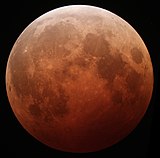
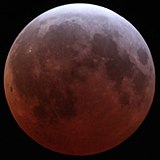
















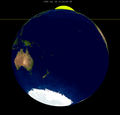







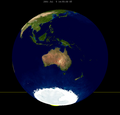


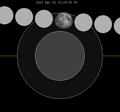


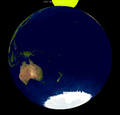






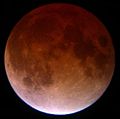



















































































Comments